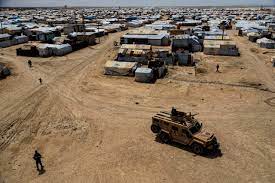California is hit by an atmospheric river that causes power outages and flooding on roads
On Sunday, California was hit by two atmospheric rivers that occurred in quick succession. The storm caused flooding on roads, cut out electricity to around 850,000 people, and prompted a rare hurricane-force wind warning as the state prepared for several days of torrential rain.

Throughout the San Francisco Bay Area, the storm submerged streets and toppled trees and power lines. In some places, the storm reached speeds of 60 mph (96 kph). In the highlands, gusts as high as 80 mph (128 kph) were reported.
Emergency personnel in San Jose, just to the south, rescued individuals from a homeless camp along a rising river and forced the occupants of a vehicle that was immobilized by flooding out of the windows.
Authorities in Southern California issued evacuation orders for canyons scorched in recent wildfires that are very vulnerable to mudslides and debris flows, and they issued warnings of possibly catastrophic floods. There will be “one of the most dramatic weather days in recent memory,” the National Weather Service office headed for Los Angeles said.
According to assistant manager Lupita Vital, consumers phoned the Santa Barbara Home Improvement Center on Sunday with questions about generators, flashlights, and sandbags. She stated that because sandbags were sold out on Saturday, people were purchasing sacks of fertilizer and potting soil in their place.
According to Vital on Sunday, “people are trying to get anything that’s heavy to use it as, you know, protection for their doors and everything.”
Santa Barbara County Sheriff Bill Brown told reporters on Saturday that “this storm is predicted to be one of the largest and most significant in our county’s history, and our goal is to get through it without any fatalities or serious injuries.” Schools around the county, which was severely damaged by mudslides brought on by strong storms in 2018, were forced to postpone classes on Monday.
According to Alexis Herrera, who was attempting to rescue his automobile from floodwater, the coastal city of Ventura, west of Los Angeles, was experiencing dangerous circumstances due to strong gusts and heavy rain. “Every freeway in this area is flooded,” Herrera said in Spanish. “I’m not sure how I’m going to transport my vehicle.”
By Sunday night, over 847,000 consumers lacked electricity across the state, with coastal areas seeing the majority of the outages, according to poweroutage.us.
According to the Storm Prediction Center, there was little chance that waterspouts would come onshore and turn into tornadoes in six counties in the San Francisco Bay Area. The San Francisco Chronicle claims that the center last predicted a tornado danger in the area in February 2015.
Winds at San Francisco International Airport resulted in delays lasting hours. By 2:30 p.m. FlightAware, a monitoring service, said that 69 flights were canceled and 155 planes were delayed on Sunday.
The ski resort Palisades Tahoe, which is located around 200 miles (320 kilometers) northeast of San Francisco, said that it was expecting the most snowfall of the season so far, with accumulations of up to two feet (60 centimeters) and up to 6 inches (15 centimeters) every hour. In the Sierra Nevada, heavy snowfall was predicted through Monday. Drivers were advised to stay off mountain routes.
After the system that blew in last week, most of the state had been drying out, which resulted in floods and the welcome deposit of snow in the mountains. Known as the “Pineapple Express” because to its wet plume that spreads across the Pacific to almost reach Hawaii, the most recent storm made landfall in Northern California on Saturday as the majority of the state was under a wind, surf, or flood watch.
A rare “hurricane force wind warning” was issued by the meteorological service for the Central Coast on Sunday. Wind gusts as high as 92 mph (148 kph) were predicted to reach from the Monterey Peninsula to the northern part of San Luis Obispo County.
However, due to the system’s sluggish motion, Southern California was at danger of significant floods starting late Sunday, according to Ryan Kittell, a meteorologist with the weather service’s Los Angeles office.
The low pressure system’s core is located quite near to us, deep below the surface, and moving extremely slowly. And it explains why the winds are so powerful here. At a briefing on Sunday, he said, “And the slow nature of it is really giving us the highest rainfall totals and the flooding risk.”
In the mountain and canyon regions of Monterey, Santa Barbara, Ventura, and Los Angeles counties, there were orders to evacuate and warnings to do so. Lindsay Horvath, the county supervisor for Los Angeles, asked locals living close to the Topanga and Soledad canyon wildfire burn sites to follow evacuation instructions in case of mudslides.
At a Sunday briefing, Horvath warned, “If you haven’t already, please gather your family, your pets, your medications, and leave immediately.” The county provided overnight accommodations for evacuees.
A state of emergency was proclaimed for the counties of Los Angeles, Orange, Riverside, San Bernardino, San Diego, San Luis Obispo, Santa Barbara, and Ventura by Governor Gavin Newsom on Sunday. The Governor’s Office of Emergency Services set up an operations center and placed staff and supplies in the highest-risk locations.
The storm was predicted to proceed down the coast, bringing with it mountain snow, flash floods, and a lot of rain to the Los Angeles region by late Sunday. On Monday, it was predicted to wreak havoc on Orange and San Diego counties.
“This is a dangerous system with significant risks to property and life,” the LA-area office of the weather service said. “Any instructions to evacuate should be followed by residents. Avoid driving this afternoon until at least Monday morning, particularly on the highways.
The Grammy Awards, which are held in downtown Los Angeles, were expecting to wrap up on Sunday night before the worst rainstorm arrived.
The second-largest school district in the country, Los Angeles Unified School District, said on Sunday afternoon that it will resume regular operations on Monday. Superintendent Alberto Carvalho said that the choice will be reevaluated on Monday at six in the morning.
The meteorological service predicted up to 8 inches (20 cm) of rain in the valley and coastal regions of Southern California, with the possibility of 14 inches (35 cm) in the foothills and mountains. Up to Tuesday, Southern California is forecast to get heavy to moderate rain.







